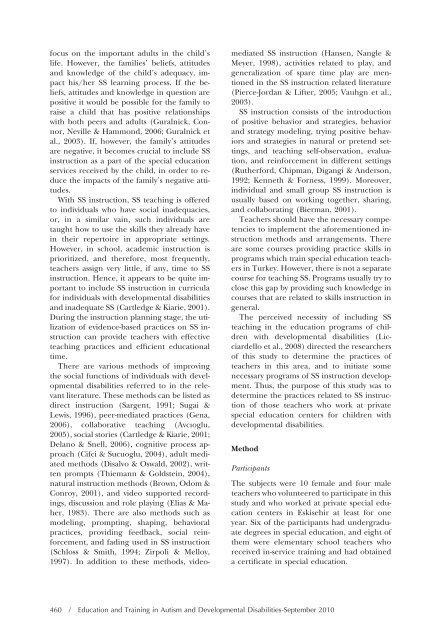Education and Training in Autism and Developmental Disabilities
Education and Training in Autism and Developmental Disabilities
Education and Training in Autism and Developmental Disabilities
You also want an ePaper? Increase the reach of your titles
YUMPU automatically turns print PDFs into web optimized ePapers that Google loves.
focus on the important adults <strong>in</strong> the child’s<br />
life. However, the families’ beliefs, attitudes<br />
<strong>and</strong> knowledge of the child’s adequacy, impact<br />
his/her SS learn<strong>in</strong>g process. If the beliefs,<br />
attitudes <strong>and</strong> knowledge <strong>in</strong> question are<br />
positive it would be possible for the family to<br />
raise a child that has positive relationships<br />
with both peers <strong>and</strong> adults (Guralnick, Connor,<br />
Neville & Hammond, 2006; Guralnick et<br />
al., 2003). If, however, the family’s attitudes<br />
are negative, it becomes crucial to <strong>in</strong>clude SS<br />
<strong>in</strong>struction as a part of the special education<br />
services received by the child, <strong>in</strong> order to reduce<br />
the impacts of the family’s negative attitudes.<br />
With SS <strong>in</strong>struction, SS teach<strong>in</strong>g is offered<br />
to <strong>in</strong>dividuals who have social <strong>in</strong>adequacies,<br />
or, <strong>in</strong> a similar va<strong>in</strong>, such <strong>in</strong>dividuals are<br />
taught how to use the skills they already have<br />
<strong>in</strong> their repertoire <strong>in</strong> appropriate sett<strong>in</strong>gs.<br />
However, <strong>in</strong> school, academic <strong>in</strong>struction is<br />
prioritized, <strong>and</strong> therefore, most frequently,<br />
teachers assign very little, if any, time to SS<br />
<strong>in</strong>struction. Hence, it appears to be quite important<br />
to <strong>in</strong>clude SS <strong>in</strong>struction <strong>in</strong> curricula<br />
for <strong>in</strong>dividuals with developmental disabilities<br />
<strong>and</strong> <strong>in</strong>adequate SS (Cartledge & Kiarie, 2001).<br />
Dur<strong>in</strong>g the <strong>in</strong>struction plann<strong>in</strong>g stage, the utilization<br />
of evidence-based practices on SS <strong>in</strong>struction<br />
can provide teachers with effective<br />
teach<strong>in</strong>g practices <strong>and</strong> efficient educational<br />
time.<br />
There are various methods of improv<strong>in</strong>g<br />
the social functions of <strong>in</strong>dividuals with developmental<br />
disabilities referred to <strong>in</strong> the relevant<br />
literature. These methods can be listed as<br />
direct <strong>in</strong>struction (Sargent, 1991; Sugai &<br />
Lewis, 1996), peer-mediated practices (Gena,<br />
2006), collaborative teach<strong>in</strong>g (Avcıoglu,<br />
2005), social stories (Cartledge & Kiarie, 2001;<br />
Delano & Snell, 2006), cognitive process approach<br />
(Cifci & Sucuoglu, 2004), adult mediated<br />
methods (Disalvo & Oswald, 2002), written<br />
prompts (Thiemann & Goldste<strong>in</strong>, 2004),<br />
natural <strong>in</strong>struction methods (Brown, Odom &<br />
Conroy, 2001), <strong>and</strong> video supported record<strong>in</strong>gs,<br />
discussion <strong>and</strong> role play<strong>in</strong>g (Elias & Maher,<br />
1983). There are also methods such as<br />
model<strong>in</strong>g, prompt<strong>in</strong>g, shap<strong>in</strong>g, behavioral<br />
practices, provid<strong>in</strong>g feedback, social re<strong>in</strong>forcement,<br />
<strong>and</strong> fad<strong>in</strong>g used <strong>in</strong> SS <strong>in</strong>struction<br />
(Schloss & Smith, 1994; Zirpoli & Melloy,<br />
1997). In addition to these methods, video-<br />
mediated SS <strong>in</strong>struction (Hansen, Nangle &<br />
Meyer, 1998), activities related to play, <strong>and</strong><br />
generalization of spare time play are mentioned<br />
<strong>in</strong> the SS <strong>in</strong>struction related literature<br />
(Pierce-Jordan & Lifter, 2005; Vauhgn et al.,<br />
2003).<br />
SS <strong>in</strong>struction consists of the <strong>in</strong>troduction<br />
of positive behavior <strong>and</strong> strategies, behavior<br />
<strong>and</strong> strategy model<strong>in</strong>g, try<strong>in</strong>g positive behaviors<br />
<strong>and</strong> strategies <strong>in</strong> natural or pretend sett<strong>in</strong>gs,<br />
<strong>and</strong> teach<strong>in</strong>g self-observation, evaluation,<br />
<strong>and</strong> re<strong>in</strong>forcement <strong>in</strong> different sett<strong>in</strong>gs<br />
(Rutherford, Chipman, Digangi & Anderson,<br />
1992; Kenneth & Forness, 1999). Moreover,<br />
<strong>in</strong>dividual <strong>and</strong> small group SS <strong>in</strong>struction is<br />
usually based on work<strong>in</strong>g together, shar<strong>in</strong>g,<br />
<strong>and</strong> collaborat<strong>in</strong>g (Bierman, 2001).<br />
Teachers should have the necessary competencies<br />
to implement the aforementioned <strong>in</strong>struction<br />
methods <strong>and</strong> arrangements. There<br />
are some courses provid<strong>in</strong>g practice skills <strong>in</strong><br />
programs which tra<strong>in</strong> special education teachers<br />
<strong>in</strong> Turkey. However, there is not a separate<br />
course for teach<strong>in</strong>g SS. Programs usually try to<br />
close this gap by provid<strong>in</strong>g such knowledge <strong>in</strong><br />
courses that are related to skills <strong>in</strong>struction <strong>in</strong><br />
general.<br />
The perceived necessity of <strong>in</strong>clud<strong>in</strong>g SS<br />
teach<strong>in</strong>g <strong>in</strong> the education programs of children<br />
with developmental disabilities (Licciardello<br />
et al., 2008) directed the researchers<br />
of this study to determ<strong>in</strong>e the practices of<br />
teachers <strong>in</strong> this area, <strong>and</strong> to <strong>in</strong>itiate some<br />
necessary programs of SS <strong>in</strong>struction development.<br />
Thus, the purpose of this study was to<br />
determ<strong>in</strong>e the practices related to SS <strong>in</strong>struction<br />
of those teachers who work at private<br />
special education centers for children with<br />
developmental disabilities.<br />
Method<br />
Participants<br />
The subjects were 10 female <strong>and</strong> four male<br />
teachers who volunteered to participate <strong>in</strong> this<br />
study <strong>and</strong> who worked at private special education<br />
centers <strong>in</strong> Eskisehir at least for one<br />
year. Six of the participants had undergraduate<br />
degrees <strong>in</strong> special education, <strong>and</strong> eight of<br />
them were elementary school teachers who<br />
received <strong>in</strong>-service tra<strong>in</strong><strong>in</strong>g <strong>and</strong> had obta<strong>in</strong>ed<br />
a certificate <strong>in</strong> special education.<br />
460 / <strong>Education</strong> <strong>and</strong> <strong>Tra<strong>in</strong><strong>in</strong>g</strong> <strong>in</strong> <strong>Autism</strong> <strong>and</strong> <strong>Developmental</strong> <strong>Disabilities</strong>-September 2010

















